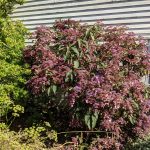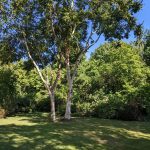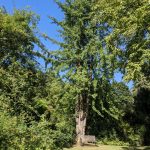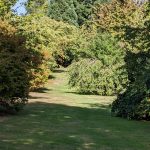
White House Farm – Maurice Foster
On another bright and sunny afternoon a group of nearly 20 members gathered in the garden of White House Farm, under the expansive boughs of a fallen very old Bramley apple tree; we were greeted and made to feel welcome by Maurice Foster and his [daughter] Claire. Maurice introduced the visit by talking about the development of his garden, where he has lived for 50 years, and which started as completely derelict. The garden itself spreads over about 5 acres, to which he has added a 2.5 acre “wood” and 7 acres of arboretum, which contains many exotic and interesting specimens of which 95% are wild collected. Maurice has 77 champion trees, many from his significant tree collections of Betula, Carpinus, Acer and Sorbus, and, of course, an extensive collection of Hydrangea, for which Maurice is particularly noted and where he has and is continuing to develop many different cultivars. Maurice has long expounded and practiced the close-boscage system of gardening, which is based around close planting of bushes, shrubs and trees, which allows enough room to express the character of the different plants but also provides sufficient canopy cover to suppress the undergrowth.

Maurice then roused us to tour around the garden, where several hydrangea were pointed out, including the cultivar Rosemary Foster, named after his own wife.

Sadly, the weather had resulted in an early end to flowering, but the leaf shapes and colours were admired. Also in the garden Maurice pointed out many tree birches, including one, which would – in his words – be his “desert island birch” – a cultivar named “Buddha” .

Maurice also pointed out a 40-year old Gingko Biloba, which had been cut back to ground level but, unexpectedly regrown four stems which had inter-twined to show the very interesting tree now on show. The garden also provided an opportunity to share tricks and tips – in this case to deter rabbits and deer; Maurice has for some time successfully used what he described as “smelly sticks” – sticks with a bundle of rags soused in Jeyes Liquid!

On our way to the Arboretum we passed through a section of the woodland area, which holds some of Maurice’s earliest tree collection; the Arboretum itself is home to many specimens of rare trees and is the newest area of planting. When Maurice acquired the land it had previously been a strawberry PYO field, and was overrun by bramble and other invasive plants. Over 27 years the area has been cleared and planted up, and we started by admiring a cherry avenue topped and tailed by two 27-year old Sequoia Wellingtonia, already boasting an impressive size.
Maurice and Claire pointed out many specimens of hydrangea cultivars that were being “tested” before potential commercial propagation and sale as well as the tree Betula Lumenifera, which is considered a weed in its native China, but holds the place as the fastest growing birch tree globally. In this area Maurice explained how best to plan the best planting site for hydrangea, which appreciate sunlight but not full sunshine; use a tall tree as reference and plot and mark where when the sun is at its height the tree casts shade; plant your hydrangea (depending on soli conditions) where the shade falls.
We were taken back to our starting point via the Hydrangea Avenue, which when in bloom displays 100 colours of blossom. When seated again, we were generously treated to more refreshments before departure.

